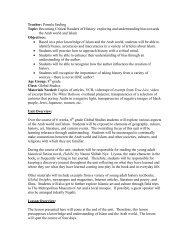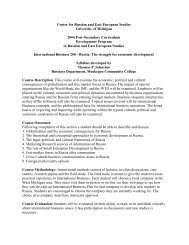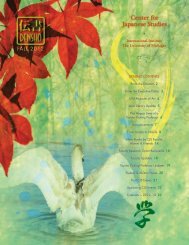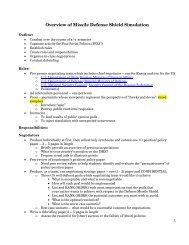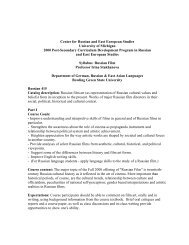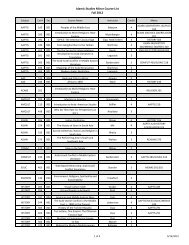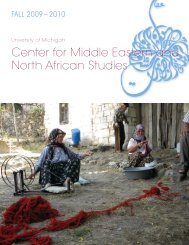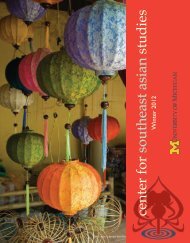The Pianist as Holocaust Instruction
The Pianist as Holocaust Instruction
The Pianist as Holocaust Instruction
Create successful ePaper yourself
Turn your PDF publications into a flip-book with our unique Google optimized e-Paper software.
<strong>The</strong> <strong>Pianist</strong> <strong>as</strong> <strong>Holocaust</strong> <strong>Instruction</strong><br />
Prepared by<br />
Maureen Schoenherr<br />
Davison High School, Flint, MI<br />
CREES Fulbright-Hays Group Projects Abroad<br />
Study Tour of Poland<br />
July 1-31, 2002
Curriculum Unit 4-6 Weeks Junior High to High School<br />
<strong>The</strong> <strong>Pianist</strong><br />
Objectives<br />
In the course of using this unit, students should:<br />
· Gain an understanding of the <strong>Holocaust</strong>, narrative writing, WWII<br />
· Acquire a b<strong>as</strong>ic understanding of Polish history of WWII<br />
· Connect to current events<br />
· Develop an essay b<strong>as</strong>ed on ide<strong>as</strong> from non-fiction<br />
· Read a variety of writing: fiction, non-fiction, poetry<br />
· Recognize acts of comp<strong>as</strong>sion and courage<br />
· Recognize the difficulties of surviving under adverse conditions<br />
· Recognize example’s of man’s inhumanity and humanity to man<br />
· Recognize acts of resistance in the face of great personal danger<br />
· Recognize connections between history and literature<br />
<strong>The</strong> Curriculum<br />
Introduction<br />
Illustrated History of Poland<br />
Map of Poland<br />
Map of Europe Pre-WWII<br />
Read <strong>The</strong> <strong>Pianist</strong><br />
<strong>The</strong> novel is broken down into four parts (flexible – make it 6 if you’d like) to guide<br />
discussion, create study guide questions, quizzes, and writing opportunities.<br />
Students will: Keep a response journal: quotes, ide<strong>as</strong>, reader-author relationship,<br />
discussion topics<br />
Keep a diary at home<br />
Discussion Guide Outline<br />
This can be done in pairs or groups and sometimes <strong>as</strong> whole cl<strong>as</strong>s. Students should use<br />
response journal, diary, study questions and personal observations to guide discussions<br />
Part I Chapters 1-3<br />
Chp. 1 - Laws and restrictions, Working in the ghetto, Dise<strong>as</strong>e and suffering, Children<br />
Chp. 2 - Reactions to war, Citizens, <strong>The</strong> family<br />
Chp. 3 - Death, destruction, and deception<br />
Part I Materials/Activities
Pictures of Warsaw pre-WWII<br />
Brief description of Jewish life in Warsaw<br />
Pictures of Westerplatte<br />
Part II Chapters 4 - 6<br />
Chp. 4 - Laws and restrictions, Early brutality, Hint of the ghetto<br />
Chp. 5 - Curfew, Winter, Jewish council, Cities fall, Proganda<br />
Chp. 6 - Choldna Street, Gestapo, Meals at home, “Meals” in the street<br />
Part II Materials/Activities<br />
Chopin’s Nocturne in C minor<br />
<strong>The</strong> Warsaw Ghetto: 1940 – 1943<br />
Map of the ghetto<br />
Pictures of the ghetto<br />
Select appropriate Yiddish and Polish Proverbs<br />
Postcards of Warsaw Ghetto<br />
Part III Chapters 7 - 10<br />
Chp. 7- Jews vs. Jews, <strong>The</strong> camps, Lies, Competition<br />
Chp. 8 - Cut off, Work, Orphans<br />
Chp. 9 - Violence incre<strong>as</strong>es, <strong>The</strong> compound, Horrors, Saved<br />
Chp. 10 - On his own, Outside the ghetto, Reality and charity, More selections<br />
Part III Materials/Activities<br />
Auschwitz: A History in Photographs<br />
Pictures and postcards from Auschwitz<br />
Pictures of Umschlagplatz<br />
Select appropriate Yiddish and Polish Proverbs<br />
Stories from “This Way for the G<strong>as</strong>, Ladies and Gentlemen.”<br />
“Farewell to Manzanar”<br />
Part IV Chapters 11 - 13
Chp. 11 - Work, Stirrings, Absurdity, Irony<br />
Chp. 12 - It begins, Tensions rise<br />
Chp. 13 - At the piano once more, Hiding, Allies in Africa, Resistance, Suicide<br />
Part IV Materials/Activities<br />
Select appropriate Yiddish and Polish Proverbs<br />
“Rosa Robota,” “A Manifesto of the Jewish Resistance in Vilna”<br />
Select appropriate poems from <strong>The</strong> Auschwitz Poems<br />
Part V Chapters 14 – 16<br />
Chp. 14 – Betrayal, Rescue, Flight, A near escape from death, <strong>The</strong> advance of the Allies<br />
Chp. 15 - Rebellion, Panic, Fire, Suicide<br />
Chp. 16 – Resurrection, To the hospital, Hiding and survival, Rebels found<br />
Part V Materials/Activities<br />
Select appropriate Yiddish and Polish Proverbs<br />
Read select biographies from <strong>The</strong> History Net website<br />
Part VI Chapters 17, 18 & Postscript<br />
Chp. 17 - Alone, Mental practice, A trade, Encounters, Found<br />
Chp. 18 - Humanity, At the piano once more, Winter, Liberation<br />
Postscript<br />
Part VI Materials/Activities<br />
Monuments to the uprising and the suffering – view pictures<br />
Select appropriate Yiddish and Polish Proverbs<br />
Watch <strong>The</strong> <strong>Pianist</strong><br />
Writing Opportunities<br />
Using quotes from response journals and observations in the response journals, have<br />
students reflect on
Research the Jewish resistance efforts in and out of the camps. Presentation method can<br />
vary: PowerPoint, poster, artifacts<br />
Create a newspaper covering the events of the Warsaw Ghetto Uprising. Include an<br />
editorial page addressing issues covered in this unit.<br />
Research the U.S.’s response to Jewish refugees.<br />
Review websites on the <strong>Holocaust</strong>. Address the different views and tactics.<br />
Bibliography and Suggested Readings<br />
B<strong>as</strong>iura, Ewa. <strong>The</strong> Jews of Poland in Tale and Legend. Storyteller, Krakow: 1997<br />
Borowski, Tadueusz. This Way for the G<strong>as</strong>, Ladies and Gentlemen. Penguin, New York:<br />
1976.<br />
Gross, Jan T. Neighbors: <strong>The</strong> Destruction of the Jewish Community in Jedwabne, Poland.<br />
Princeton University Press, Princeton: 2001.<br />
Luczynska, Zofia. Jewish Kazimierz Short Guide. Studio Zebra, Krakow.<br />
Piper, Franciszek. Auschwitz: How Many Perished – Jews, Poles, Gypsies. Yad V<strong>as</strong>hem<br />
Studies, Krakow: 1991.<br />
Pogonowski, Janusz. Illicit Letters From Auschwitz. Frap-Books, Poland.<br />
Sitarz, Magdalena. Yiddish and Polish Proverbs. Krakow, 2000.<br />
Steele, Victoria. Ties of Blood. Mieczyslaw Staner, Krafow.<br />
Swiebocka, Teresa. Auschwitz: A History in Photographs. Indiana University Press,<br />
Bloomington and Indianapolis: 2002.<br />
Szpilman, Wladyslaw. <strong>The</strong> <strong>Pianist</strong>. Phoeniz, London: 2002.<br />
Zych, Adam A. <strong>The</strong> Auschwitz Poems. Auschwitz-Birkenau State Museum, Oskwiecim:<br />
1999.<br />
Additional Media Options<br />
Video<br />
Auschwitz: History – Present – Future<br />
Documentary of the Polish camps and present day efforts to confront the aftermath<strong>The</strong><br />
Diary of <strong>The</strong> Diary of Anne Frank<br />
Adaption of the play, 170 min.<br />
Flames in the Ashes: <strong>Holocaust</strong> Documentaries<br />
Documentary of Jewish resistance, 90 mins.<br />
<strong>The</strong> <strong>Pianist</strong><br />
Adaptation of the novel<br />
Not Like Sheep to the Slaughter: <strong>The</strong> Story of the Bialystok Ghetto<br />
Documentary of Jewish resistance in Polish ghetto, 150 mins.<br />
Uprising<br />
Dramatic vision of Warsaw ghetto uprising
Music<br />
Gorecki. Symphony No. 3 Opus 36 ‘Symphony of Sorrowful Songs.’<br />
Kroke. Eden.<br />
Trio Galicyjskie. Di Galitzyaner Klezmorim<br />
CD-ROM<br />
Images From the <strong>Holocaust</strong><br />
Websites<br />
“<strong>The</strong> Warsaw Ghetto Uprising"<br />
Edelman, Marek. <strong>The</strong> Ghetto Fights<br />
A Teacher’s Guide to the <strong>Holocaust</strong>. “Gallery – Warsaw Ghetto Uprising.”<br />
“<strong>The</strong> Warsaw Ghetto.” <strong>The</strong> History Net.



